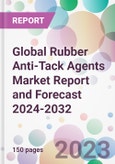According to the report, the global rubber anti-tack agents market is projected to grow at a CAGR of 4.5% between 2024 and 2032 reaching a value of around USD 1319.98 million by 2032..Aided by the expanding rubber industry, the increasing demand for high-quality rubber products, and the critical role anti-tack agents play in rubber processing, the market is expected to grow significantly by 2032.
Rubber anti-tack agents are essential additives employed in the rubber industry to mitigate the tackiness of rubber products during their storage. The inherent tacky nature of uncured rubber compounds can lead to issues during storage and transportation, as the rubber products can stick to each other and to the processing equipment, thereby complicating further processing. Anti-tack agents address this challenge, ensuring smoother processing and maintaining the quality of the final rubber products.
A pivotal driver for the global rubber anti-tack agents market growth is the consistent demand from the automotive sector. Tires, seals, gaskets, and various other rubber components utilised in vehicles require high-quality rubber, which, in turn, necessitates the use of anti-tack agents during their production. As the automotive industry continues its growth trajectory, the consumption of rubber components and, subsequently, rubber anti-tack agents, is expected to remain robust.
Additionally, the ever-growing footwear industry is significantly contributing to the rubber anti-tack agents market demand. With rubber being a primary material for shoe soles, the need for anti-tack agents in ensuring the efficient production of quality footwear is undeniable. The increasing global population coupled with the evolving fashion trends ensures a steady demand in this sector.
Moreover, other industries like electronics, where rubber is used for seals, gaskets, and insulation, and healthcare, where rubber is utilised in gloves, tubes, and seals, further bolster the demand for rubber anti-tack agents.
According to the rubber anti-tack agents market analysis, technological advancements in the formulation and application of rubber anti-tack agents are playing a crucial role in market evolution. Modern anti-tack agents not only prevent sticking but also enhance the overall properties of rubber, making them more durable, flexible, and resistant to various environmental factors.
Rubber anti-tack agents are essential additives employed in the rubber industry to mitigate the tackiness of rubber products during their storage. The inherent tacky nature of uncured rubber compounds can lead to issues during storage and transportation, as the rubber products can stick to each other and to the processing equipment, thereby complicating further processing. Anti-tack agents address this challenge, ensuring smoother processing and maintaining the quality of the final rubber products.
A pivotal driver for the global rubber anti-tack agents market growth is the consistent demand from the automotive sector. Tires, seals, gaskets, and various other rubber components utilised in vehicles require high-quality rubber, which, in turn, necessitates the use of anti-tack agents during their production. As the automotive industry continues its growth trajectory, the consumption of rubber components and, subsequently, rubber anti-tack agents, is expected to remain robust.
Additionally, the ever-growing footwear industry is significantly contributing to the rubber anti-tack agents market demand. With rubber being a primary material for shoe soles, the need for anti-tack agents in ensuring the efficient production of quality footwear is undeniable. The increasing global population coupled with the evolving fashion trends ensures a steady demand in this sector.
Moreover, other industries like electronics, where rubber is used for seals, gaskets, and insulation, and healthcare, where rubber is utilised in gloves, tubes, and seals, further bolster the demand for rubber anti-tack agents.
According to the rubber anti-tack agents market analysis, technological advancements in the formulation and application of rubber anti-tack agents are playing a crucial role in market evolution. Modern anti-tack agents not only prevent sticking but also enhance the overall properties of rubber, making them more durable, flexible, and resistant to various environmental factors.
Market Segmentation
The market can be divided based on type and region.
Market Breakup by Type
- Stearates
- Fatty Acid Esters
- Fatty Acid Amides
- Soaps
- Others
Market Breakup by Region
- North America
- Europe
- Asia Pacific
- Latin America
- Middle East and Africa
Competitive Landscape
The report looks into the market shares, plant turnarounds, capacities, investments, and mergers and acquisitions, among other major developments, of the leading companies operating in the global rubber anti-tack agents market. Some of the major players explored in the report are as follows:- Hallstar Innovations Corp.
- Lion Specialty Chemicals Co., Ltd. (TYO: 4912)
- McGee Industries, Inc.
- Sasco Chemical Group, Inc.
- Schill + Seilacher"Struktol" GmbH
- Others
Table of Contents
1 Preface2 Report Coverage - Key Segmentation and Scope4 Key Assumptions7 Opportunities and Challenges in the Market16 Key Trends and Developments in the Market
3 Report Description
5 Executive Summary
6 Snapshot
8 Global Rubber Anti-Tack Agents Market Analysis
9 North America Rubber Anti-Tack Agents Market Analysis
10 Europe Rubber Anti-Tack Agents Market Analysis
11 Asia Pacific Rubber Anti-Tack Agents Market Analysis
12 Latin America Rubber Anti-Tack Agents Market Analysis
13 Middle East and Africa Rubber Anti-Tack Agents Market Analysis
14 Market Dynamics
15 Competitive Landscape
List of Key Figures and Tables
Companies Mentioned
- Hallstar Innovations Corp.
- Lion Specialty Chemicals Co. Ltd. (TYO: 4912)
- McGee Industries Inc.
- Sasco Chemical Group Inc.
- Schill + Seilacher 'Struktol' GmbH
Methodology

LOADING...








